specifications FIAT DUCATO BASE CAMPER 2015 Owner handbook (in English)
[x] Cancel search | Manufacturer: FIAT, Model Year: 2015, Model line: DUCATO BASE CAMPER, Model: FIAT DUCATO BASE CAMPER 2015Pages: 367, PDF Size: 19.73 MB
Page 246 of 367
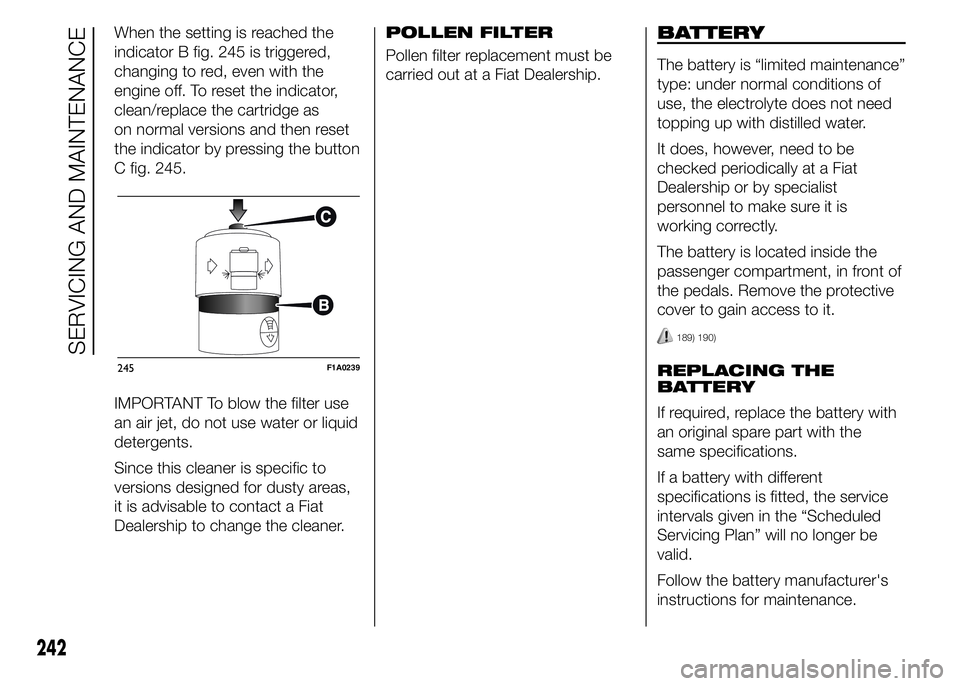
When the setting is reached the
indicator B fig. 245 is triggered,
changing to red, even with the
engine off. To reset the indicator,
clean/replace the cartridge as
on normal versions and then reset
the indicator by pressing the button
C fig. 245.
IMPORTANT To blow the filter use
an air jet, do not use water or liquid
detergents.
Since this cleaner is specific to
versions designed for dusty areas,
it is advisable to contact a Fiat
Dealership to change the cleaner.POLLEN FILTER
Pollen filter replacement must be
carried out at a Fiat Dealership.BATTERY
The battery is “limited maintenance”
type: under normal conditions of
use, the electrolyte does not need
topping up with distilled water.
It does, however, need to be
checked periodically at a Fiat
Dealership or by specialist
personnel to make sure it is
working correctly.
The battery is located inside the
passenger compartment, in front of
the pedals. Remove the protective
cover to gain access to it.
189) 190)
REPLACING THE
BATTERY
If required, replace the battery with
an original spare part with the
same specifications.
If a battery with different
specifications is fitted, the service
intervals given in the “Scheduled
Servicing Plan” will no longer be
valid.
Follow the battery manufacturer's
instructions for maintenance.245F1A0239
242
SERVICING AND MAINTENANCE
Page 249 of 367
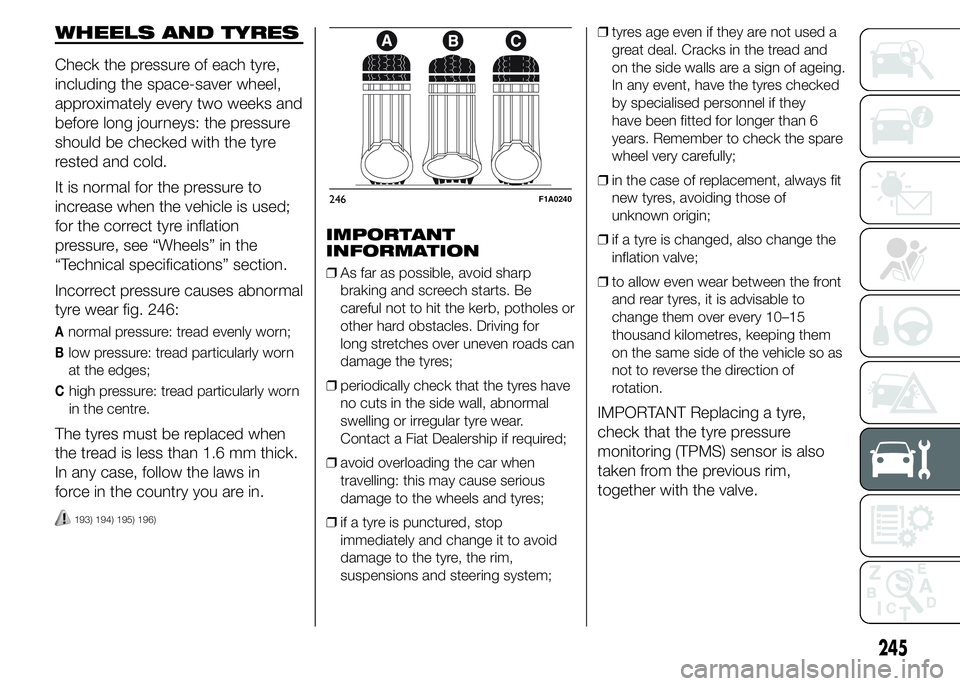
WHEELS AND TYRES
Check the pressure of each tyre,
including the space-saver wheel,
approximately every two weeks and
before long journeys: the pressure
should be checked with the tyre
rested and cold.
It is normal for the pressure to
increase when the vehicle is used;
for the correct tyre inflation
pressure, see “Wheels” in the
“Technical specifications” section.
Incorrect pressure causes abnormal
tyre wear fig. 246:
Anormal pressure: tread evenly worn;
Blow pressure: tread particularly worn
at the edges;
Chigh pressure: tread particularly worn
in the centre.
The tyres must be replaced when
the tread is less than 1.6 mm thick.
In any case, follow the laws in
force in the country you are in.
193) 194) 195) 196)
IMPORTANT
INFORMATION
❒As far as possible, avoid sharp
braking and screech starts. Be
careful not to hit the kerb, potholes or
other hard obstacles. Driving for
long stretches over uneven roads can
damage the tyres;
❒periodically check that the tyres have
no cuts in the side wall, abnormal
swelling or irregular tyre wear.
Contact a Fiat Dealership if required;
❒avoid overloading the car when
travelling: this may cause serious
damage to the wheels and tyres;
❒if a tyre is punctured, stop
immediately and change it to avoid
damage to the tyre, the rim,
suspensions and steering system;❒tyres age even if they are not used a
great deal. Cracks in the tread and
on the side walls are a sign of ageing.
In any event, have the tyres checked
by specialised personnel if they
have been fitted for longer than 6
years. Remember to check the spare
wheel very carefully;
❒in the case of replacement, always fit
new tyres, avoiding those of
unknown origin;
❒if a tyre is changed, also change the
inflation valve;
❒to allow even wear between the front
and rear tyres, it is advisable to
change them over every 10–15
thousand kilometres, keeping them
on the same side of the vehicle so as
not to reverse the direction of
rotation.
IMPORTANT Replacing a tyre,
check that the tyre pressure
monitoring (TPMS) sensor is also
taken from the previous rim,
together with the valve.
246F1A0240
245
Page 252 of 367
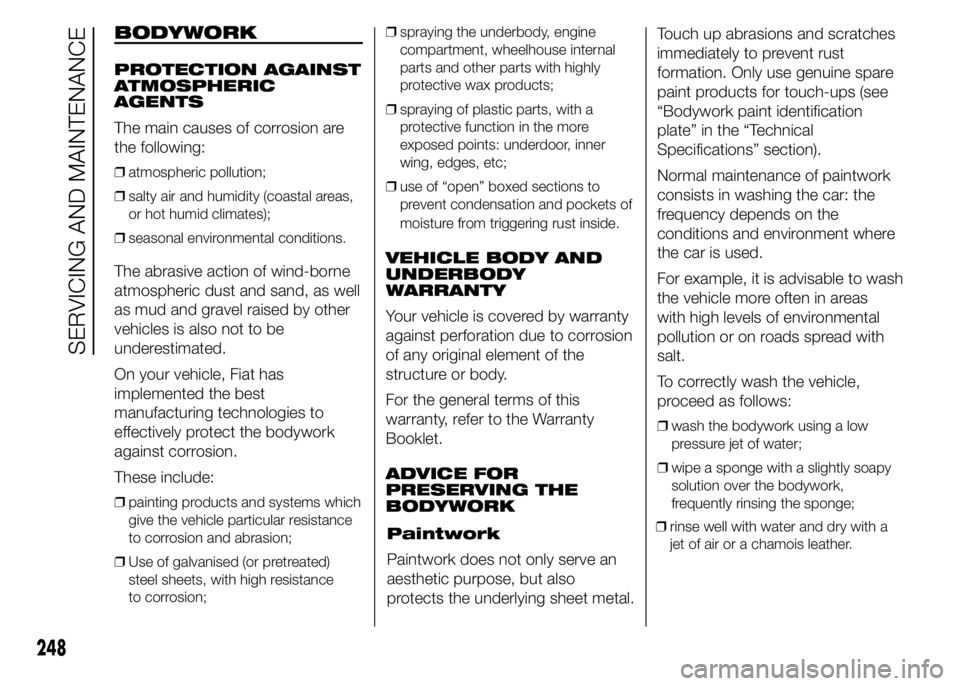
BODYWORK
PROTECTION AGAINST
ATMOSPHERIC
AGENTS
The main causes of corrosion are
the following:
❒atmospheric pollution;
❒salty air and humidity (coastal areas,
or hot humid climates);
❒seasonal environmental conditions.
The abrasive action of wind-borne
atmospheric dust and sand, as well
as mud and gravel raised by other
vehicles is also not to be
underestimated.
On your vehicle, Fiat has
implemented the best
manufacturing technologies to
effectively protect the bodywork
against corrosion.
These include:
❒painting products and systems which
give the vehicle particular resistance
to corrosion and abrasion;
❒Use of galvanised (or pretreated)
steel sheets, with high resistance
to corrosion;❒spraying the underbody, engine
compartment, wheelhouse internal
parts and other parts with highly
protective wax products;
❒spraying of plastic parts, with a
protective function in the more
exposed points: underdoor, inner
wing, edges, etc;
❒use of “open” boxed sections to
prevent condensation and pockets of
moisture from triggering rust inside.
VEHICLE BODY AND
UNDERBODY
WARRANTY
Your vehicle is covered by warranty
against perforation due to corrosion
of any original element of the
structure or body.
For the general terms of this
warranty, refer to the Warranty
Booklet.
ADVICE FOR
PRESERVING THE
BODYWORK
Paintwork
Paintwork does not only serve an
aesthetic purpose, but also
protects the underlying sheet metal.Touch up abrasions and scratches
immediately to prevent rust
formation. Only use genuine spare
paint products for touch-ups (see
“Bodywork paint identification
plate” in the “Technical
Specifications” section).
Normal maintenance of paintwork
consists in washing the car: the
frequency depends on the
conditions and environment where
the car is used.
For example, it is advisable to wash
the vehicle more often in areas
with high levels of environmental
pollution or on roads spread with
salt.
To correctly wash the vehicle,
proceed as follows:
❒wash the bodywork using a low
pressure jet of water;
❒wipe a sponge with a slightly soapy
solution over the bodywork,
frequently rinsing the sponge;
248
SERVICING AND MAINTENANCE
❒rinse well with water and dry with a
jet of air or a chamois leather.
Page 257 of 367
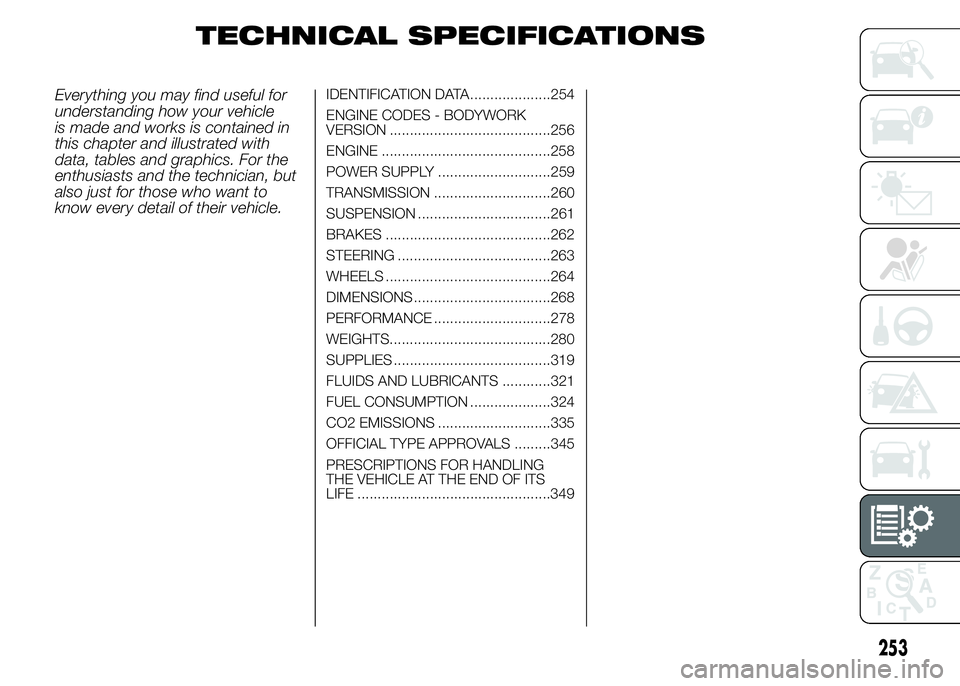
TECHNICAL SPECIFICATIONS
Everything you may find useful for
understanding how your vehicle
is made and works is contained in
this chapter and illustrated with
data, tables and graphics. For the
enthusiasts and the technician, but
also just for those who want to
know every detail of their vehicle.IDENTIFICATION DATA....................254
ENGINE CODES - BODYWORK
VERSION ........................................256
ENGINE ..........................................258
POWER SUPPLY ............................259
TRANSMISSION .............................260
SUSPENSION .................................261
BRAKES .........................................262
STEERING ......................................263
WHEELS .........................................264
DIMENSIONS ..................................268
PERFORMANCE .............................278
WEIGHTS........................................280
SUPPLIES .......................................319
FLUIDS AND LUBRICANTS ............321
FUEL CONSUMPTION ....................324
CO2 EMISSIONS ............................335
OFFICIAL TYPE APPROVALS .........345
PRESCRIPTIONS FOR HANDLING
THE VEHICLE AT THE END OF ITS
LIFE ................................................349
253
Page 258 of 367
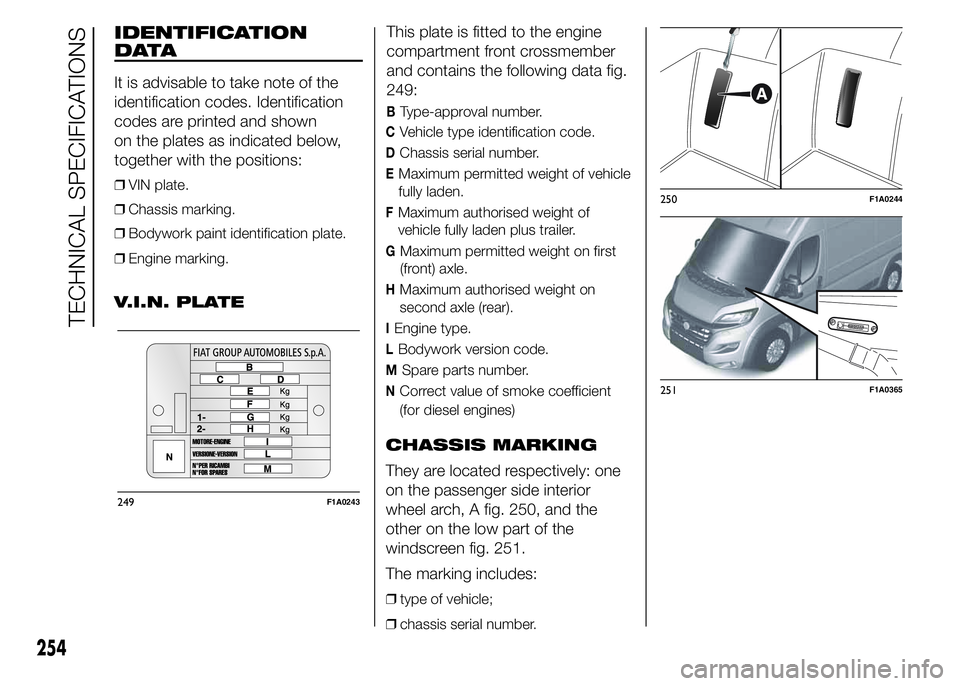
IDENTIFICATION
DATA
It is advisable to take note of the
identification codes. Identification
codes are printed and shown
on the plates as indicated below,
together with the positions:
❒VIN plate.
❒Chassis marking.
❒Bodywork paint identification plate.
❒Engine marking.
V.I.N. PLATEThis plate is fitted to the engine
compartment front crossmember
and contains the following data fig.
249:
BType-approval number.
CVehicle type identification code.
DChassis serial number.
EMaximum permitted weight of vehicle
fully laden.
FMaximum authorised weight of
vehicle fully laden plus trailer.
GMaximum permitted weight on first
(front) axle.
HMaximum authorised weight on
second axle (rear).
IEngine type.
LBodywork version code.
MSpare parts number.
NCorrect value of smoke coefficient
(for diesel engines)
CHASSIS MARKING
They are located respectively: one
on the passenger side interior
wheel arch, A fig. 250, and the
other on the low part of the
windscreen fig. 251.
The marking includes:
❒type of vehicle;
❒chassis serial number.
249F1A0243
250F1A0244
251F1A0365
254
TECHNICAL SPECIFICATIONS
Page 260 of 367
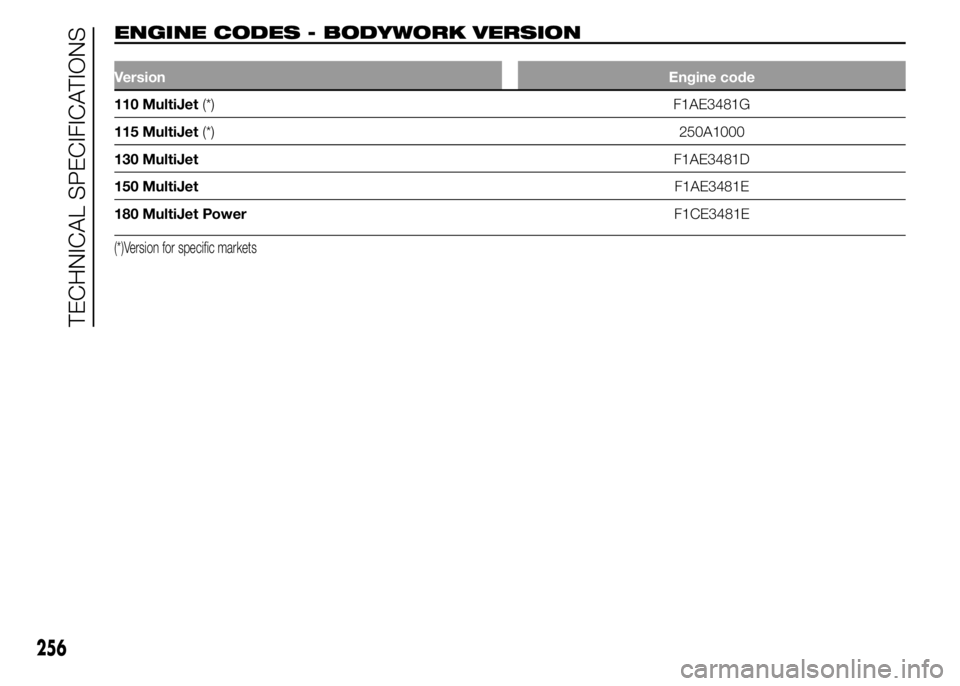
ENGINE CODES - BODYWORK VERSION.
VersionEngine code
110 MultiJet(*) F1AE3481G
115 MultiJet(*)250A1000
130 MultiJetF1AE3481D
150 MultiJetF1AE3481E
180 MultiJet PowerF1CE3481E
(*)Version for specific markets
256
TECHNICAL SPECIFICATIONS
Page 262 of 367
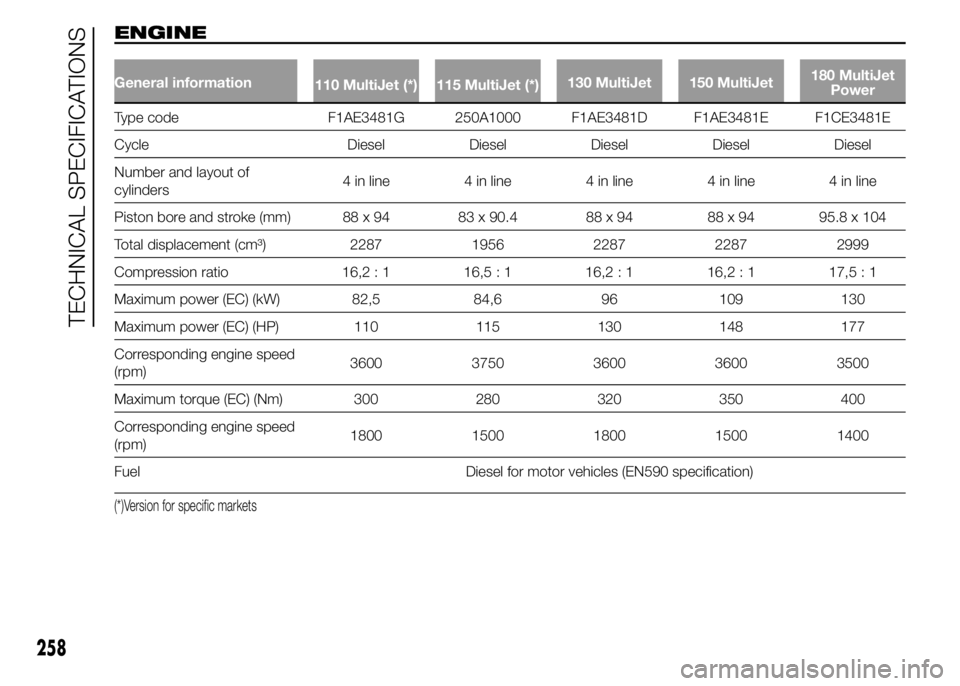
ENGINE
General information
110 MultiJet (*) 115 MultiJet (*)130 MultiJet 150 MultiJet180 MultiJet
Power
Type code F1AE3481G 250A1000 F1AE3481D F1AE3481E F1CE3481E
Cycle Diesel Diesel Diesel Diesel Diesel
Number and layout of
cylinders4 in line 4 in line 4 in line 4 in line 4 in line
Piston bore and stroke (mm) 88 x 94 83 x 90.4 88 x 94 88 x 94 95.8 x 104
Total displacement (cm³) 2287 1956 2287 2287 2999
Compression ratio 16,2 : 1 16,5 : 1 16,2 : 1 16,2 : 1 17,5 : 1
Maximum power (EC) (kW) 82,5 84,6 96 109 130
Maximum power (EC) (HP) 110 115 130 148 177
Corresponding engine speed
(rpm)3600 3750 3600 3600 3500
Maximum torque (EC) (Nm) 300 280 320 350 400
Corresponding engine speed
(rpm)1800 1500 1800 1500 1400
Fuel Diesel for motor vehicles (EN590 specification)
(*)Version for specific markets
258
TECHNICAL SPECIFICATIONS
Page 263 of 367
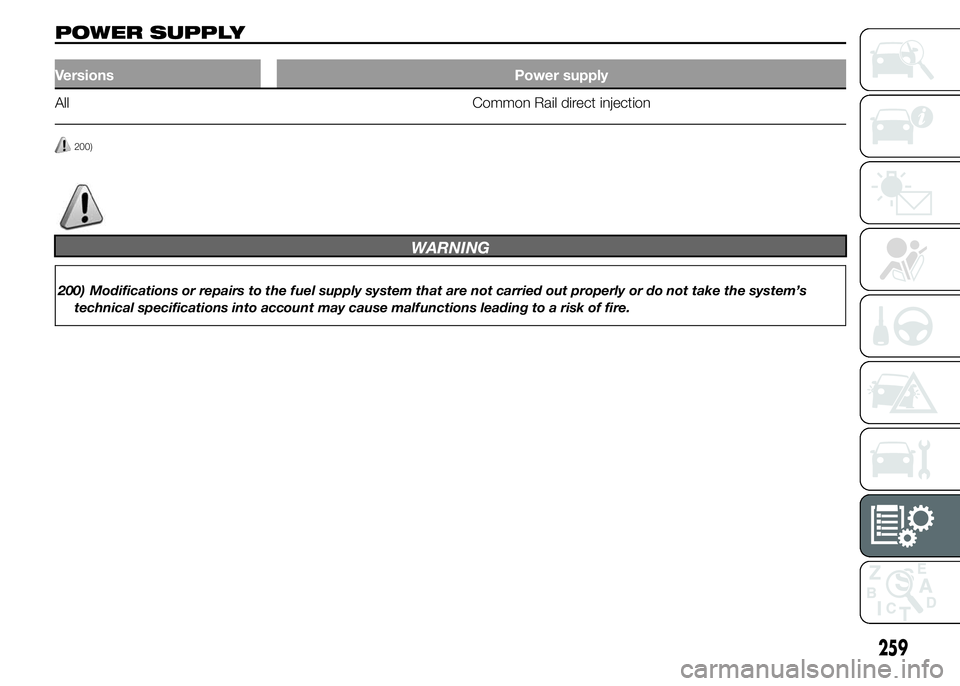
POWER SUPPLY
Versions Power supply
All Common Rail direct injection
200)
WARNING
200) Modifications or repairs to the fuel supply system that are not carried out properly or do not take the system’s
technical specifications into account may cause malfunctions leading to a risk of fire.
259
Page 264 of 367
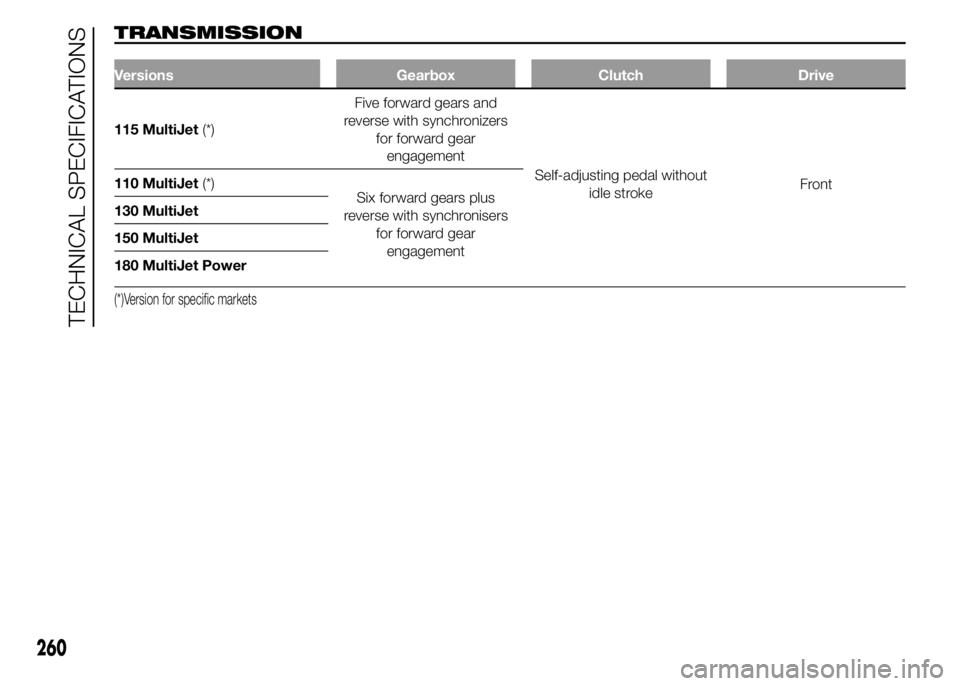
TRANSMISSION
Versions Gearbox Clutch Drive
115 MultiJet(*)Five forward gears and
reverse with synchronizers
for forward gear
engagement
Self-adjusting pedal without
idle strokeFront 110 MultiJet(*)
Six forward gears plus
reverse with synchronisers
for forward gear
engagement 130 MultiJet
150 MultiJet
180 MultiJet Power
(*)Version for specific markets
260
TECHNICAL SPECIFICATIONS
Page 266 of 367
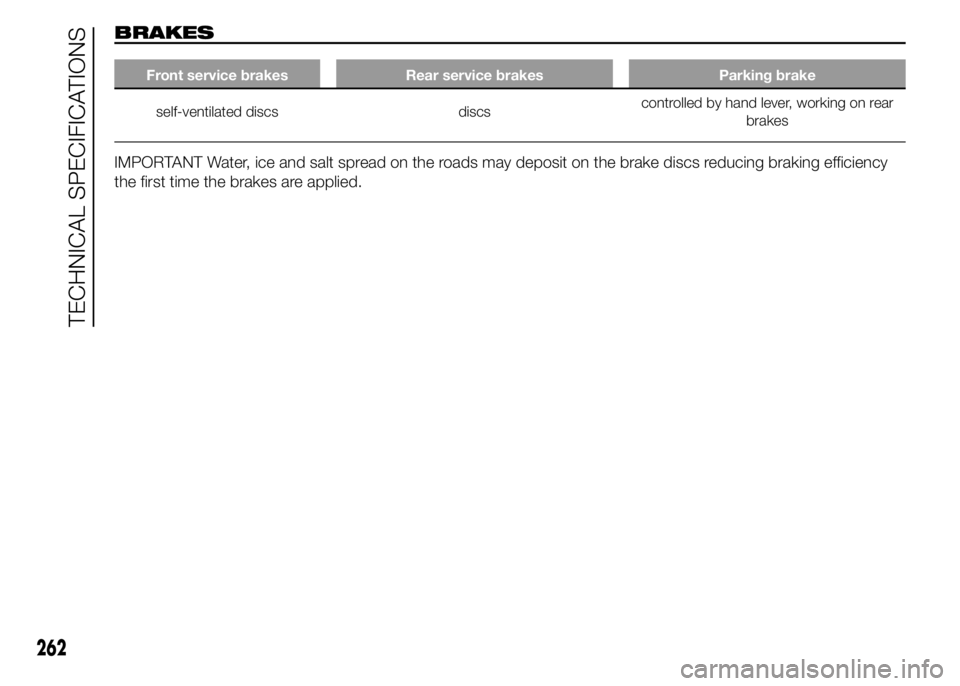
BRAKES
Front service brakes Rear service brakes Parking brake
self-ventilated discs discscontrolled by hand lever, working on rear
brakes
IMPORTANT Water, ice and salt spread on the roads may deposit on the brake discs reducing braking efficiency
the first time the brakes are applied.
262
TECHNICAL SPECIFICATIONS